| HOME |
|---|
GEMINI
The Twins
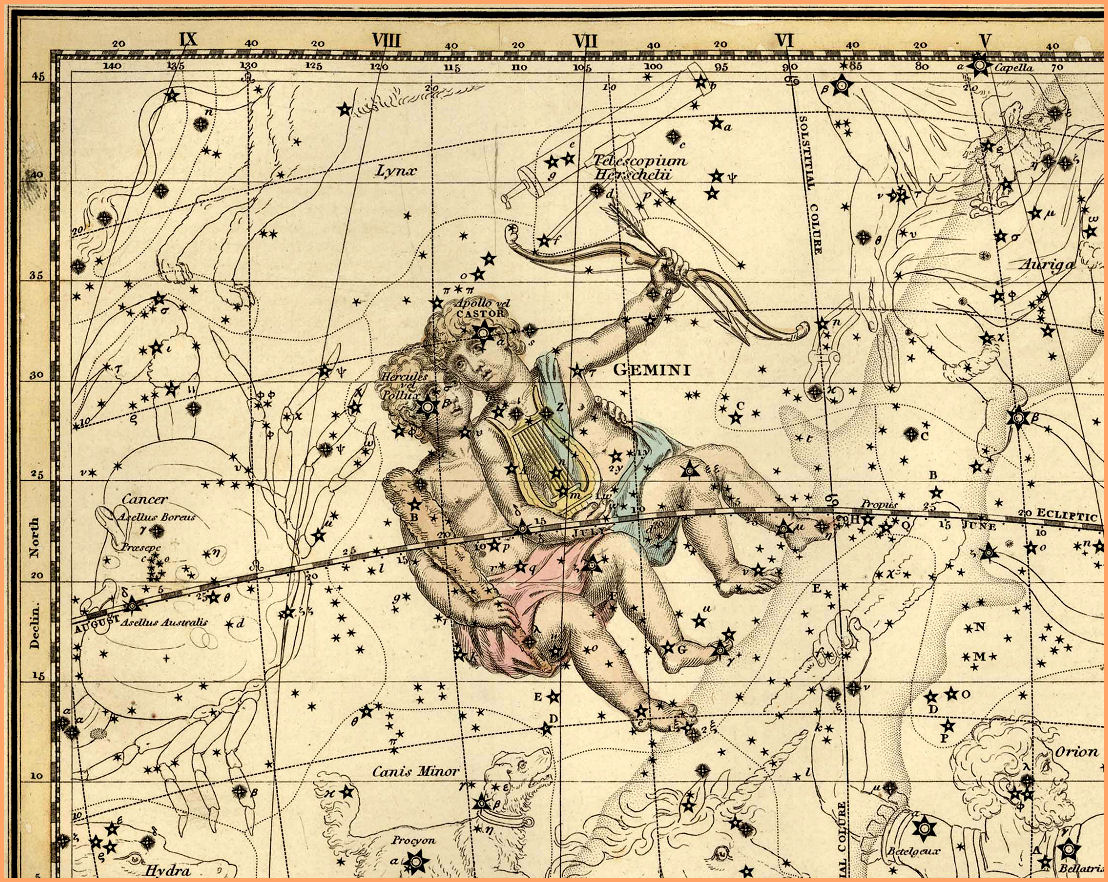
Gemini - Celestial Atlas by Alexander Jamieson - 1822
| HOME |
|---|

Following the mighty Orion across our wintry sky is the constellation of Gemini, the twins. The stars have been seen as twins of one sort or another since the dawn of time, and included in Ptomely's original 48 constellations of 149 AD. According to Greek myth the twins were born of Leda, queen of Sparta. One night the ever lustful Zeus (Jupiter), king of the gods, came to Leda in the form of a swan, and seduced her. Her husband also came to her that night, and nine months later Leda gave birth to quadruplets. From two eggs came Pollux and sister Helen, immortal offspring of Zeus, along with Castor and sister Clytaemnestra, the mortal children of her husband.
The twin sisters married Agamemnon and Menalaus, the two Greek kings who went to war with Troy, sister Helen becoming the famous "Helen of Troy". The twin brothers, Castor and Pollux were inseparable. They shared many adventures, including sailing with Jason and the Argonauts in search of the Golden Fleece. When Castor, the mortal brother, was killed in a fight, Pollux was so filled with loss that he begged his father, Zeus, to take away his immortality, so that he might die too, and be with his brother. Zeus was so impressed with his loyalty he granted the wish of Pollux, and placed their forms in the heavens, as the eternal epitome of brotherly love. Zeus's own brother, Poseidon (Neptune), god of the sea, was so impressed he granted the twins power over the winds and the waves, so that sailors for centuries have invoked their blessing on the high seas.
St. Elmo's Fire (an electrical glow that can occur in the rigging of ships during storms), was known as "Ledaean Lights", after the twins' mother, Leda, and the phrase, "By Jiminy!" comes from the ancient sea faring oath, "By Gemini!" The twins even appear in the Bible:
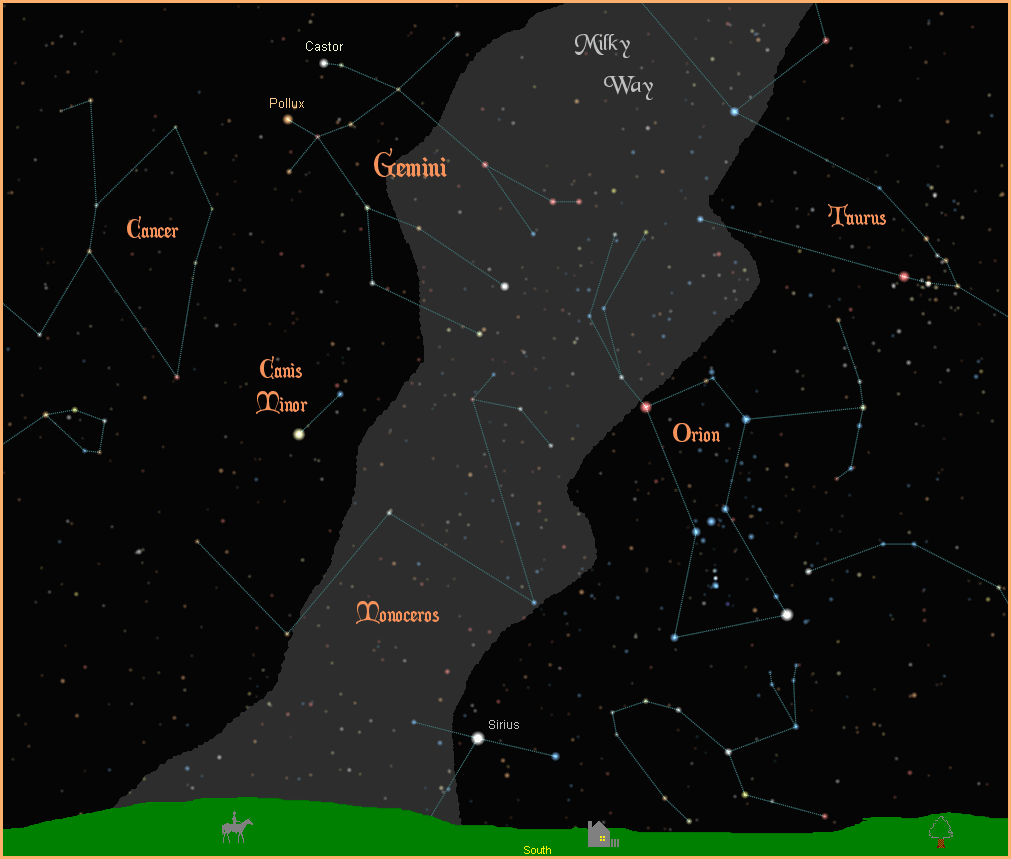
Castor, Greek for the horseman, is designated as the alpha star in the constellation, although it is actually the dimmer of the twins, with a magnitude of 1.59, leading to speculation that the star was brighter in ancient times. Although Castor appears as a single, bright white star to the naked eye, through a telescope it becomes two almost identical stars. The brighter of the pair, Castor A, is an A1 white main sequence star, and its slightly dimmer partner, Castor B, is an A2 white main sequence star. As these two stars orbit each other, a small, dim little M1 red dwarf star, Castor C, orbits the both of them. The kicker is that all three of these stars have small companion stars of their own, resulting in a rare system of six gravitationally connected stars. How fitting for one of the most famous twins of all time to be represented by a star that is itself composed of three sets of twins! The Castor sextuple star system is relatively close, only 45 light years from Earth.
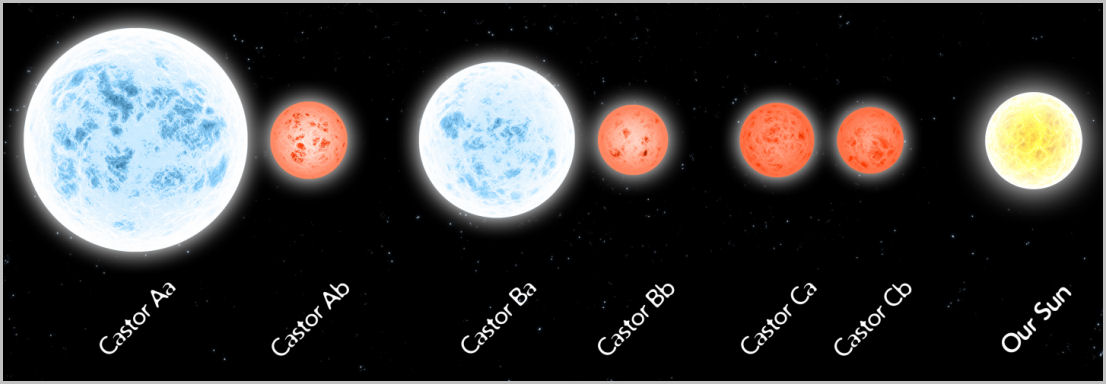
Beta Geminorum is the famous Pollux, from the Greek for pugilist or boxer. It is the brighter of the two twins, with a magnitude of 1.16, making it the 17th brightest star in the sky. Pollux is a G9III yellow/orange giant, shining with a brilliant golden hue.
The best news about Pollux is that it has a planet. Its name is Pollux b, and it's 2.3 times the size of Jupiter. It travels around Pollux in a 590 day orbit slightly larger than the orbit of Mars. A gas giant that large would not normally be conducive to life, but it could have some nice cozy moons. There could well be smaller planets around Pollux as well that are difficult to detect.
Out of the thousand or so stars known to support planetary systems, Pollux is not only the brightest of them all, it is also the fourth closest, only 33.6 light years from Earth, right next door in astronomical terms. It's exciting to gaze up at such a famous, bright, close star like Pollux, and know there are planets orbiting that star, and that there might be life up there, looking back down at us.
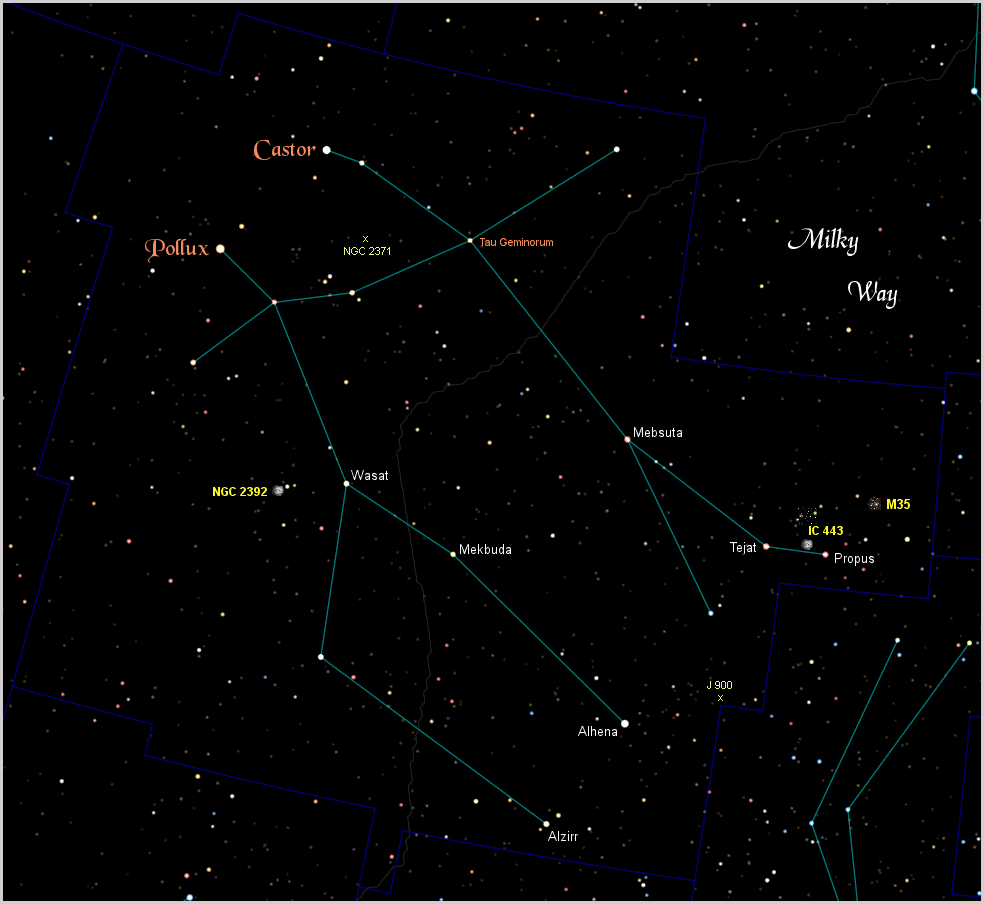
Theta Geminorum is named Alhena, taken from the Arabic name for the Lunar Mansion it represented. It is the third brightest star in Gemini with a magnitude of 1.93. It is an A1IV white subgiant, about 100 light years away. There is a very faint G class companion star that orbits it every 12 years.
Delta Geminorum is Wasat, Arabic for the geographically correct middle. It is an F2V yellow main sequence star with a magnitude of 3.5, about 60 light years away. It has one fainter K class companion star, and possibly a second, close spectroscopic companion as well.
Epsilon Geminorum is labelled Mebsuta, from the Arabic for the outstretched (paw), alluding to an ancient asterism of a lion that encompassed that entire region. It is a G9I yellow/orange supergiant, with a magnitude of 3.06, very far away at a distance of about 900 light years.
Zeta Geminorum is Mekbuda, the folded (paw) of the ancient Arabic lion mentioned above. It is a G1I yellow supergiant with a magnitude of 4.01. It is amazing we can see this star at all, considering its very great distance of 1,360 light years. Mekbuda is the brightest of all the Cepheid Variables, stars with regular deviations in luminosity that allow astronomers to make very accurate distance calculations.
Eta Geminorum very properly named Propus, the forward foot. It is a triple star system in which the primary is a semiregular variable M2III red giant with a mean magnitude of 3.5. It is about 350 light years away, and has achieved some notoriety as the star beside which the planet Uranus was discovered in 1781.
Although Mu Geminorum is the eighth and last named star, it is the fourth brightest with a magnitude of 2.87. It is named Tejat, or Tejat Posterior, very loosely translated as back of the foot. It is an M3III red giant, about 230 light years away.
In addition to the brilliant Pollux, there are five other stars in Gemini that are known to support planetary systems, and one of these, Tau Geminorum, with a magnitude of 4.4, is also visible with the naked eye. It sits right in the middle of Castor's chest, a K2II orange bright giant, and hosts a planet over 11 times larger than Jupiter. It is very far away however, at a distance of 300 light years.
For more information on these and other extrasolar planets, visit NASA's New Worlds Atlas, and The Open Exoplanets Catalogue.
The two star clusters, M35 (NGC 2168) and NGC 2158 are located within the same field of view, and are a fine sight in a backyard telescope. M35 is the larger, sparser cluster in the upper left centre of the below image. It is about 2,000 light years away. NGC 2158 is the smaller, denser cluster in the lower right of the image. It is much further away, at a distance of about 16,000 light years.
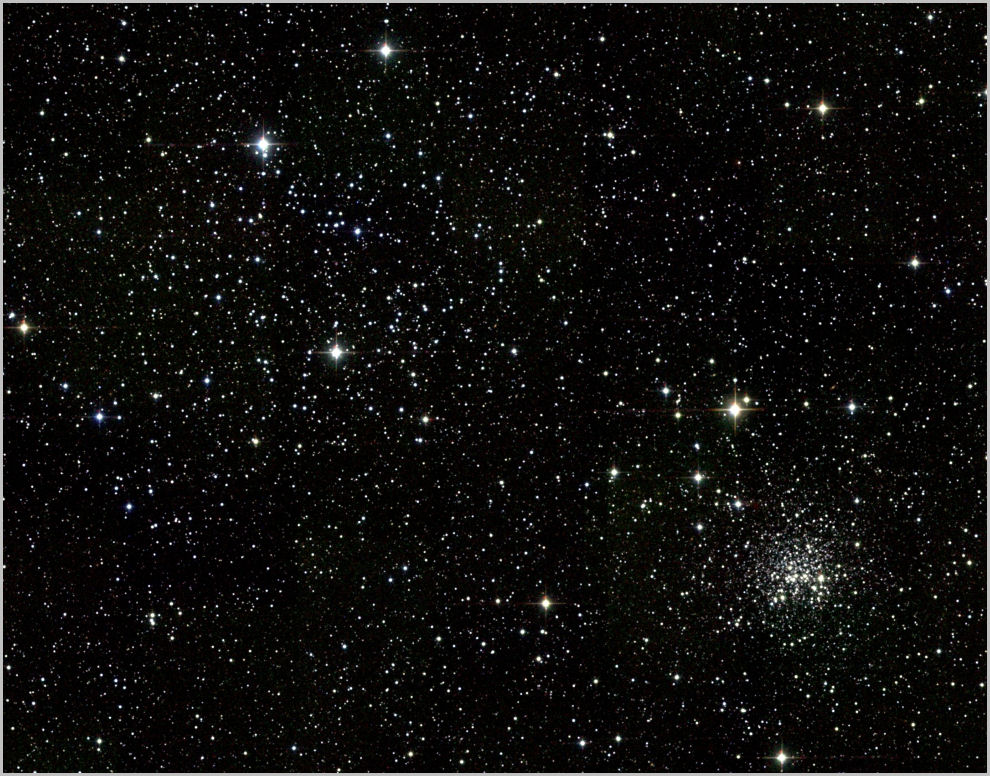
NGC 2392 is known as the Eskimo Nebula, or the Clown's Head Nebula, because that's what it looks like through a small telescope. Through the eyes of the Hubble Space Telescope we see its true nature as an expanding cloud of gas shed by a dying star. It has a magnitude of 8.6, and is about 3,000 light years away.
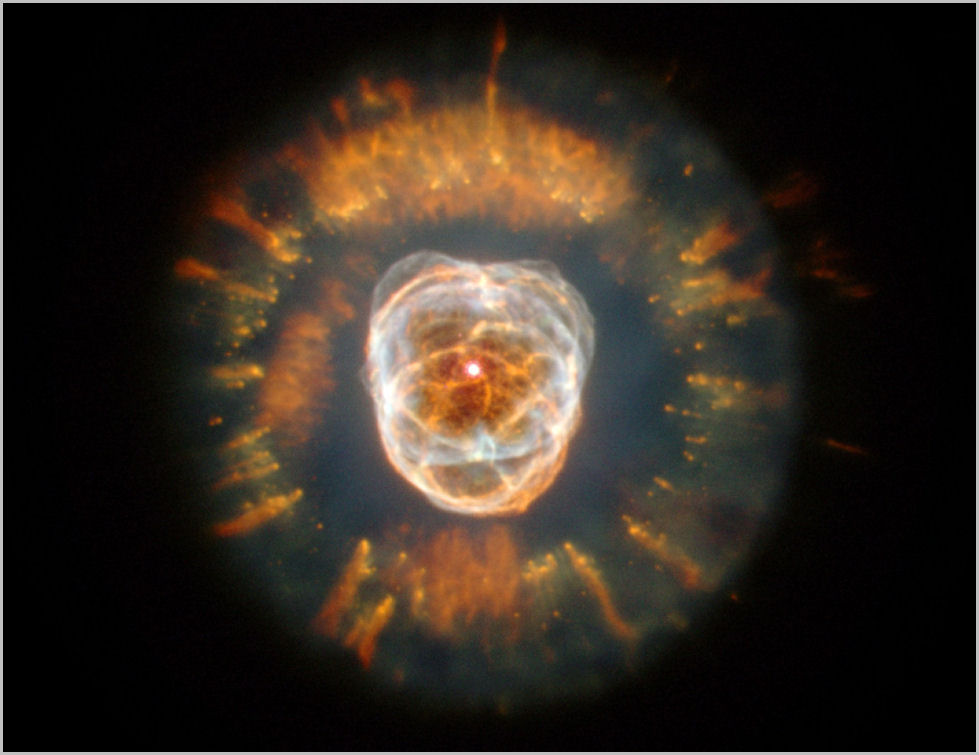
J 900 is another so called "planetary nebula", an expanding bubble of hot gas cast off by a dying star. The nebula is extremely far away, at a distance of 15,000 light years. The star beside it is very much closer.
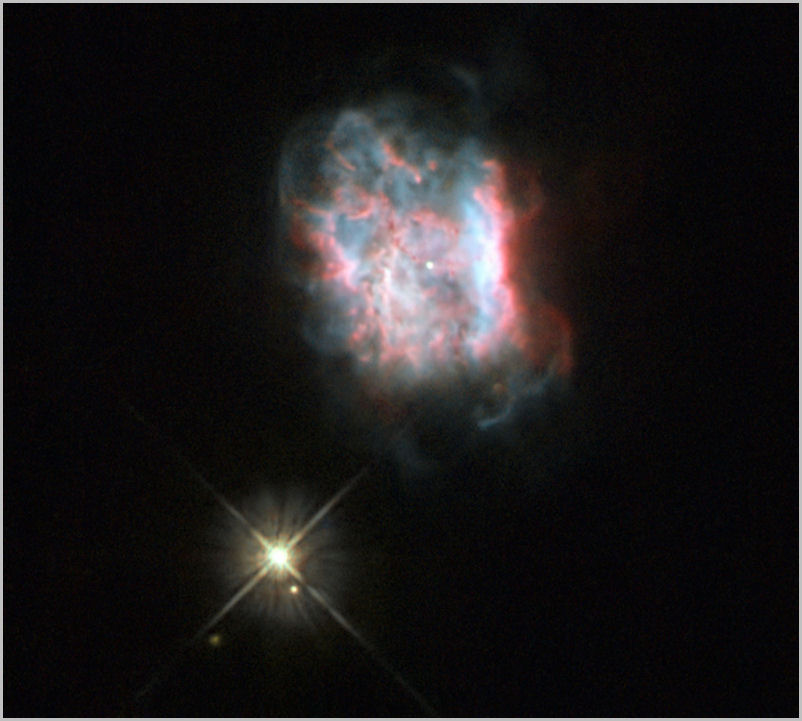
Planetary nebula NGC 2371 is about 4,300 light years away. Hubble dramatically shows us the violent activity in the superheated cocoon of ejected gas surrounding this dying star.
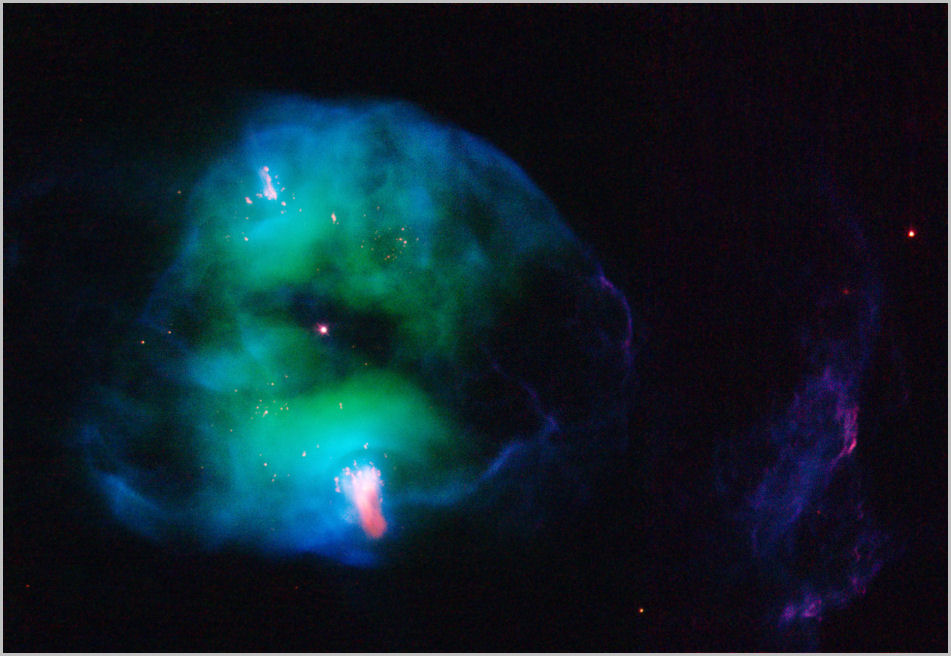
Gemini also contains another kind of nebula, a supernova remnant, IC 443, discernible only in large telescopes. The insert shows what is left of the core of the original star, transformed by the supernova explosion into a super dense neutron star (named J0617), and leaving a comet-like tail behind it as it moves through the super-heated gas of the nebula.
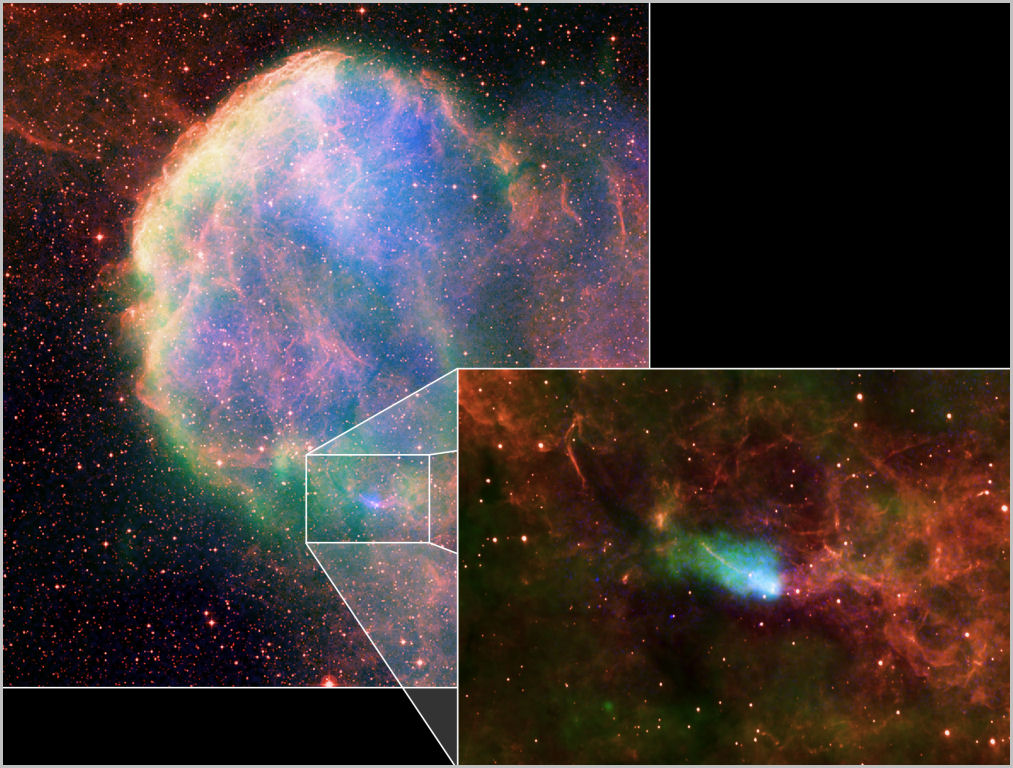
|
|
|
|
|
|